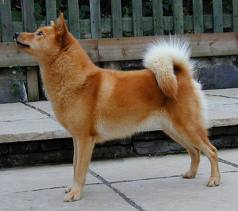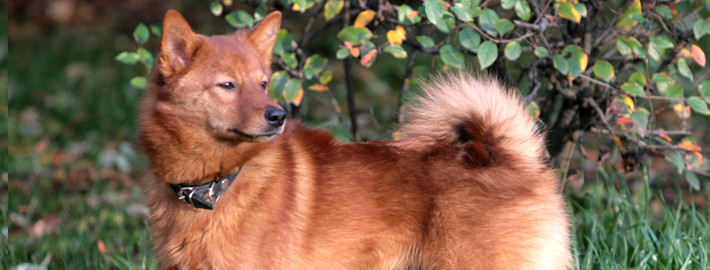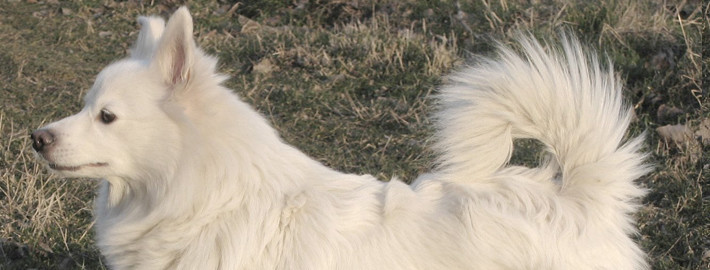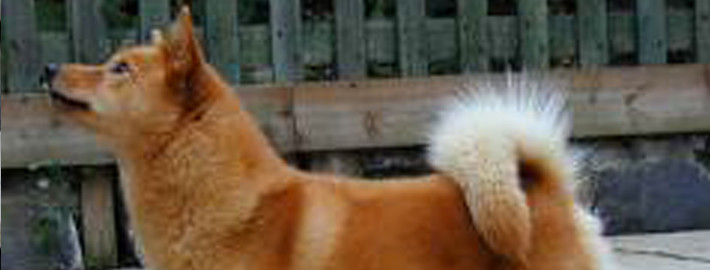What makes the Finnish Spitz Unique?
The Finnish spitz has a foxlike appearance, incorporating the typical traits of a Northern breed: small erect ears, dense double coat and curled tail. It is square-proportioned, and without exaggeration, quick and light on its feet. It has the conformation and temperament to hunt actively and tirelessly under the coldest of conditions. Its double coat, consisting of a short soft undercoat and harsh straight outer coat about 1 to 2 inches long, provides insulation from the snow and cold, allowing it to hunt tirelessly under the coldest of conditions.
Like most spitz breeds, the Finkie is independent and somewhat stubborn, although it is more hunting oriented than other spitz breeds. It is alert, inquisitive and playful, but it is also sensitive, tending to be devoted to one person. It is a breed conscious of its place in the dominance hierarchy, and some males can try to be domineering. It is good with children, and generally good with other pets, but it can be aggressive to strange dogs. It is reserved, even aloof or suspicious, with strangers. In keeping with its barking heritage, the Finkie is proud of its barking ability and likes to show it off — loudly!
Breed Groups
Page Contents

Is the Finnish Spitz Right For You?
A lively, friendly dog, the Finnish Spitz enjoys being active and spending time with his family. He is good-natured and enjoys children, although may be initially cautious with strangers. The breed requires moderate exercise and his thick double coat sheds and will need regular brushing and bathing.
If you are considering purchasing a Finnish Spitz puppy, learn more.
*Non-Sporting Group; AKC recognized in 1991.
*Ranging in size from 15½ to 20 inches tall at the shoulder.
*Bird hunter
In 5 Words
- Active
- Friendly
- Lively
- Eager
- Faithful
Characteristics
Learn About the Finnish Spitz
Description
A dog bred for hunting small game and birds, the Finnish Spitz looks rather fox-like: pointed muzzle, erect ears, dense coat and curled tail, which are all due to its northern heritage. The people of Finland are proud to recognize the Finnish Spitz as their national dog.
Short History of the Finnish Spitz
The Finnish Spitz developed from selectively bred Spitz-type dogs that inhabited central Russia several thousand years ago. Isolated Finno-Ugrian tribes in the far northern regions bred dogs according to their specific needs. These small clans of woodsmen relied on their dogs to help them obtain food, and the excellent hunting ability of the Finnish Spitz made it a favorite choice.
By 1880, as advanced means of transportation brought diverse peoples and their dogs together, Finnish Spitzes mated with other breeds of dogs, and were becoming extinct as a distinct breed. At about that time, a Finnish sportsman from Helsinki named Hugo Roos observed the pure native Finnish Spitz while hunting in the northern forests. He realized the many virtues of the pure Finnish Spitz breed and decided to select dogs that were untainted examples of the genuine Finnish Spitz in order to try to revive the breed. Thirty years of careful breeding resulted in the modern Finnish Spitz; the dogs are descendents of his original foundation stock.
Temperament
Active and friendly, lively and eager, faithful, brave but cautious. This breed is patient with children and tolerant of other household animals. They have a strong hunting instinct so they may chase smaller animals. This is an extremely intelligent breed which becomes very much a part of the family and is a dog which should be allowed to share with the family. However, this is not the breed for every family. Households where there is tension, harshness or loud bickering should not have a Finnish Spitz.
Caring for Your Finnish Spitz
General Health
The Finnish Spitz is typically a very healthy breed, with few general health concerns. However, breeders should be consulted to understand the prevalence of a specific disorder in this breed. Below is a short list of what is known to occur:
Hip dysplasia
Patellar luxation
Elbow dysplasia
Epilepsy
Grooming & Bathing
The Finnish Spitz is a meticulously clean dog, sometimes giving the impression that they groom themselves. They should be brushed weekly, especially during coat change and should only be bathed when needed. The Finnish Spitz is a natural (wash and wear) dog on whom no trimming should be done, except under the pads of the feet. Trimming the whiskers or sculpturing for the show ring is to be heavily penalized. Nails should be kept trimmed, ears and teeth cleaned.
Exercise & Training
Because of his intelligence, he is an independent and strong-willed dog and cannot be bullied. He can be trained with a firm but gentle voice and touch, and responds better to praise than correction. He is easily bored, so training sessions should be kept short and interesting. Patience is a key word when training a Finnish Spitz. You may feel as if you are making no headway and all of a sudden he will surprise you. Many Finnish Spitz do well in obedience classes if trained with a praise and reward method, as opposed to a heavy hand.










